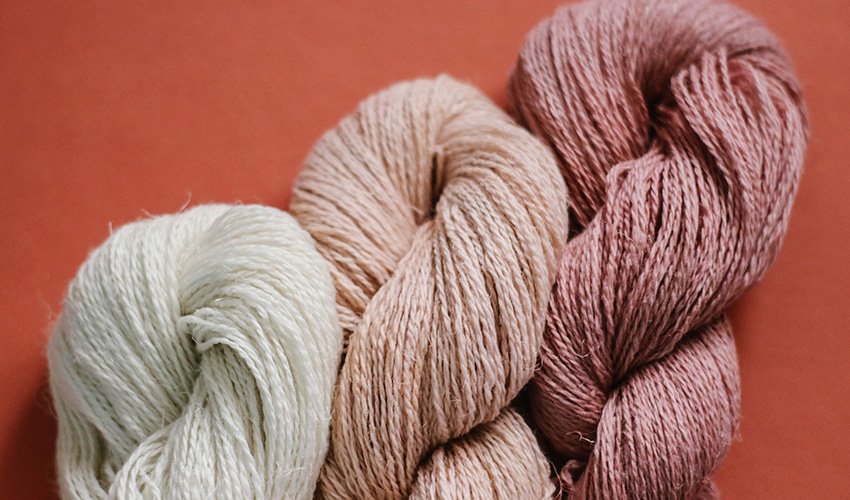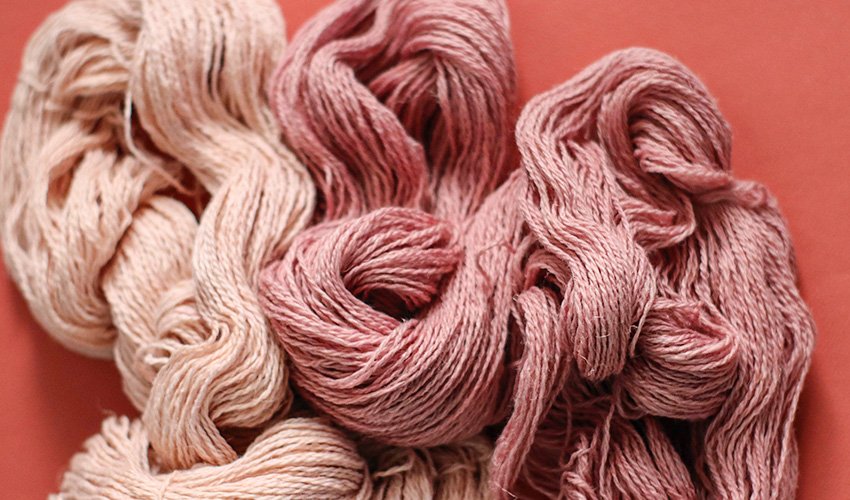Natural Dyes for Wool: Brazilwood
Did you know that many of the most used natural dyes come from the wood of trees? Many trees have color in their twigs and branches, and all we need to do as natural dyers to unlock it is grind a few up and add hot water! Depending on where you live, it may be easier to get some tree dyes than others, but this guide focuses on one of the rarest, most saturated wood dyes: Brazilwood.
Brazilwood comes in two forms for natural dyers and woodworkers: sappanwood or ‘sapwood’ is the main body of the tree. It is saturated with some color, but the deepest shades and most prized color comes from the heartwood of the tree, also known as pernambuco. I had the good fortune to be gifted some pernambuco from a violin bow maker in my region. Perhaps you’ll get just as lucky and get your hands on osage for brilliant yellows, fruit woods for a variety of soft, tan tones, or sequoia cones for rich, rusty grays.
You may be able to find wood dyes in extract form, such as logwood, but my preferred way of dyeing with wood is to create my own dye bath from the shavings or wood chips. The larger the pieces of wood you use, the longer it will take for them to break down in water–for sticks and branches, increasing your overnight soaking time to 1 week (or more) soaking in water.
The method I’ve outlined below involves many overnight steps: leaving the mordant to absorb overnight, leaving the dye to deepen overnight, etc. Each step each day should take around 2 hours of your time–1 hour to prep and 1 hour for the dye or mordant to simmer.
How to Naturally Dye Wool with Brazilwood
Materials
For this dye experiment, you’ll want the following materials on hand. Remember, anything you use for natural dyeing must not be used again for food or food prep at any time, and you’ll want to store it separately to avoid any cross-contamination.
- 1-2 large stainless steel or aluminum soup pots or stock pots
This should be big enough to hold 1-2, 100 g skeins of yarn, covered in water, and fully submerged with room to move around. If you only have one, you will need to mordant the yarn overnight, strain and wash the pot, then prepare the dye in the same pot, re-wetting the yarn and adding it to the dye bath on the 3rd day of the process, instead of being able to do both the dye prep and mordanting on day 1.
- Dedicated tools: measuring cup, spoon for stirring
- A heat source
This could be your at-home stove with good ventilation, a hot plate, a propane burner or even a crockpot. If you’d like to use an upcycled crockpot, you will not need the stockpot, but it will need to stay fully dedicated to natural dyeing as dyes are not food safe.
- A water source
Natural dyes do use a lot of water–for prepping your fibres, creating dye baths, and rinsing finished yarns. You can use rainwater if you like, especially if you find your tap water is influencing your colors negatively. You can test your water’s pH with strips and see how ‘neutral’ it is if you like.
- A respirator or face mask
I typically would not use a respirator or face mask when moving around shavings, but if you are using anything powdered–the chemicals we use to mordant, or any powdered dyes–I recommend having one on. These ultra-small particles just aren’t good to breathe in!
- A scale that can measure grams in small quantities
If you already have a baking scale, you can use it here, just make sure not to let any dyes or materials touch the scale directly. Simply use the tare function to zero-out the weight of any vessels you’re using to measure, then clean off your scale thoroughly after use.
- Aluminium sulfate or Aluminium Potassium Sulfate*
Mordants are chemicals that bind to both the fibre and color, acting as a bridge to attach color molecules to your wool. This chemical is the safest of a handful of options and is popular with many natural dyers. It will only bind color to protein fibres, not cellulose ones–so color taken by the wool may not be taken up the same way by any blended fibres (like cotton, hemp, linen, or nylon).
- Cream of Tartar*
Cream of Tartar adds a little softness back into your bath and prevents your wool from feeling too crunchy at the end of the dyeing process.
- Brazilwood shavings, extract, or powder.
I’ve used shavings for my experiment here, but this can be hard to find. You can easily substitute any wood-based dye powder or shaving (osage, cutch, quebracho, applewood, logwood) for brazilwood.
- 2 skeins of Knomad Bristle
For this dye experiment, I am using Knomad Bristle, a 70% Fine Organic Merino Wool blended with 30% hemp. Hemp might retain some dye, but because it is a cellulose fibre, and we are mordanting for protein fibres, any color retention is not reliable. This will result in a softly heathered yarn!
- Old clothes
Brazilwood makes bright orange and red marks that are hard to wash out! Don’t risk your favorite clothes while dyeing.
- Gloves
Rubber gloves or kitchen gloves, which can be re-used multiple times, are my preference here. While most natural dyes are perfectly safe to handle with your hands, you’ll be washing, rinsing, and in and out of the water a lot, which can damage your nails and cuticles. Keep those knitting hands pretty and get some gloves.
*These items have been pre-calculated in the amount you need for this project, dyeing 200 g of wool, however, you’ll need to do your own calculations using the mordanting guide below.
Step 1: Prep your fibre. Knomad pre-scours and washes their yarns before shipping them to us, so there should be no need to heavily clean the fibres–simply remove the tags, leaving all the ties, and open the hank into a big loop. Add reinforcement ties if you feel they’re necessary, and soak the fibre in warm water for an hour to get it fully saturated (typically 1 hour).
Step 2: Measure the alum. Wearing a respirator or face mask, measure out 12% of your weight of fibre (WOF) in alum sulfate. Here’s the math for our experiment:
200 x 0.12 = 24 g of aluminum sulfate
Hot tip: weigh out how much alum is in a tablespoon (dedicated tablespoon) and then calculate moving forward about how many tablespoons you’ll need to simplify future measuring.
Step 3: Add hot water to your alum in a small mixing container. I like to use empty, recycle-ready plastic containers. Stir the alum and water mixture until the alum is fully dissolved and the water looks cloudy or clear but has no visible grains in the bottom of the container. Measure out 1 tbsp of Cream of Tartar and dissolve it into the water while it’s still warm.
Step 4: Transfer your mordanting solution to a larger stockpot, and fill with enough water to cover your skeins of yarn (don’t add them until the pot has all the water in it). Stir and then add your yarn, moving it around to let it fully absorb the mordanting solution. Set on low heat and simmer (do not boil) for 1 hour. Allow to cool overnight with the yarn in the solution.
If you have only one pot, you’ll need to wait until tomorrow to do this step. If you are using more than one pot, you can prepare the dye bath the same day that you mordant as follows.
Step 5: Measure out your dye goods.
If you are using shavings, wood chips, bark, or sticks:
I am using Brazilwood shavings, so the volume of the shavings is easy to measure out, weigh and use immediately–it is not concentrated. This is fine if you are using wood chips, sticks or bark–just measure out approximately the same amount of dye goods as your fibre, cover with water, and simmer for 1 hour.
If you are using a powdered wood:
Measure out 1 tsp per 100 g of fibre and see how you like the results. Often, these powdered woods are a bit more potent and require less dye to fibre in the ratio. Powders should be prepared with smaller quantities of water and left overnight to more thoroughly mix, or these dyes have a tendency to separate and make one part of your project darker than the other (or have little speckles, which can be cool, if that’s what you wanted). I mix powdered dyes up in a bottle with a well-sealing lid, fill the bottle halfway with water and shake a few times over the course of the day.
Regardless of which way you prep your dye, leave it overnight to fully develop.
Step 6: On the day you are ready to dye, strain your dye bath into a cookpot, removing any shavings, bark, wood chips, or grains that may get caught in your yarn. Set aside.
Step 7: Prepare the yarn. Drain the water from your yarn soak, and push a little of the extra retained water out with your fingers. Not too much–liquid being held by the fibre will help draw the dye into the yarn, so we don’t want to take it all out and risk too much splotchiness in the final fibre. Add your yarns gently to the dye bath, making sure that yarn has enough room to move around but is mostly submerged in the pot. If you need more water, it’s okay to add some here.
Step 5: Place your pot on the heat source of your choice and increase the temperature gradually to a heat just under simmering. If you have a thermometer, you’re going to first lift the temperature to 90 F (32 C), stir, and then lift the temperature again to 180 F (82 C). I don’t have a thermometer, so I just eyeball it, and that’s okay too. You want the water hot enough for steam to be rising off it, but not so hot that it’s bubbling, boiling, or moving your yarn around for you. Keep the dye bath at this temperature for an hour, stirring occasionally to move the fibres around and keep them from collecting dye only on one side. After an hour, turn the heat off and let it cool.
Step 6: Lift a bit of your yarn from the pot and evaluate the color–remember, it will typically be 1-2 shades lighter than what you see on the wet fibre. If you like the color as-is, remove the yarn from the pot and move to the next step. If you would like to see the color deepen or strengthen a bit, leave it in the pot overnight, stirring one more time before you go to bed.
Step 7: Remove your yarns from the dye bath and smoosh out some of the extra dye–set the wool aside. Fill a sink, basin, or bucket with room temperature water and add your yarn, moving it around with your hands to allow dye release. When the water is dark, drain it and do this step again. Rinse until the water is mostly clear to ensure that no dye particles will transfer to hands or clothing while working with the finished yarns. If you want, you can add a little bit of wool wash to one of these rinse baths to improve the softness and scent of your finished yarn.
Step 8: Hang your hanks of yarn to dry out of the direct sun (I like to use a portable hanging rack in the bathtub). They will drip a little bit, so if you need to dry them indoors, I suggest putting them in a bathtub or in a room with a drain (like a basement). Depending on your humidity and weather, it can take 1-2 days for yarn to fully dry, but maneuvering it so that the same part of the hank is not always hanging down can help move this process along a bit.
I hope you enjoyed this little tutorial for dyeing with wood shavings! I love the range that Brazilwood provides: in strong concentrations, we get rosy, blush tones, but when you use lighter concentrations, you can achieve softer corals and lighter ballet pinks. It’s a very versatile material! Remember, you can use these same instructions to try any other wood shavings, bark, branches, or powders, like Cutch, Quebracho, Osage, or Applewood.
Tags: bristle, Natural dyes














